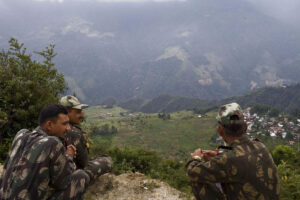The Indo-Nepal relations have now suffered a setback after the latter started claiming “Lipulekh, Kalapani and Limpiyadhura” which is part of the Indian state of Uttarakhand. The Nepal Parliament voted in a special session in favour of the Constitutional Amendment Bill to include these regions in its latest political map and emblem. Nepal has thus grafted its territorial dispute in stone, making concessions virtually unthinkable by this or any future Nepalese Government.
The dispute is at the time when there is an ongoing tension at the Line of Actual Control. After the release of the new map, Nepalese PM delivered a shocking statement by claiming that “Virus from India looks more lethal than Chinese and Italian”. India already made its clear stand on the dispute by stating that India would not accept such “artificial enlargement of territorial claims”, and urged the Himalayan nation to “create a positive atmosphere for diplomatic dialogue to resolve the outstanding boundary issues”.
The road that connects “Pithoragarh in Uttarakhand with Lipulekh Pass” is considered by Nepal as part of its own territory at the Indo-Sino border. The dispute originated in the “Sugauli Agreement”, which Nepal signed with the British EIC in December 1815. The Agreement, which classified the Kali River as the border of India and Nepal in the area, still applies to both New Delhi and Kathmandu.
Kathmandu claims that the Kali River came from the “Limpiyadhura River” and therefore “Kalapani and Lipulekh” are part of Nepal’s territory on the eastern side of the stream. But New Delhi says that what Kathmandu actually called Kali River is actually a rivulet that joins the main rivulet called “Lipu Gad”. It asserts that the River Kali begins where the “Lipu Gad” meets the river from the “Kalapani Springs”, which makes the “Lipulekh Pass, Kalapani and Limpiyadhura” a part of India. The present article discusses the treaties signed between the two nations to resolve the border disputes, the proxy role China behind the present dispute and how the border dispute is impacting the Indo-Nepal relations.
TREATIES AND INTERNATIONAL LAW
India and Nepal both had enjoyed friendly relations in the past but in the recent few years both the nations had witnessed tensions across their borderlines. Several treaties have been laid down to avoid any escalation of conflict of this nature and to ensure peace across the border. The most important ones are the “India-Nepal treaty of peace and friendship, 1950” and the “Treaty of Sugauli, 1816”.
India-Nepal treaty of Peace and Friendship, 1950
In the year 1950, “Government of India” and “Government of Nepal”, acknowledging their past ties and to perpetuate peace between the two nations, had entered into a “Treaty of Peace and Friendship”. Under Article 1 of the above-mentioned treaty both the nations had agreed to ensure peace and friendship between the two nations and also agreed to acknowledge and respect “sovereignty”, “territorial integrity” and “independence” of each other.
The Nepal government had time and again contended that the 1950 Treaty is obsolete and outmoded and there is a need to revise the treaty. Several arguments are raised to strengthen this claim. Professor Lok Raj Baral, the former ambassador of Nepal to India had mentioned that the (page number11) “treaty was concluded on a different setting and with a different objective. The 1950 context is no longer relevant.” Also, professor Kamal Prakash Malla had stated that (page number 178) “in practice, the treaty has been modified to a considerable extent.”
Though the arguments and the strife of opinion raised by the Nepal government do not hold water, the Nepal government under Article 10 can terminate the said treaty by providing a one year of prior notice. However, a mere “change of government” or a “change of circumstances” does not invalidate it. The rule of “rebus sic stantibus” which means “fundamental change of circumstances” mentioned in the “Article 62” of the “Vienna Convention” states the same. In the International arena, the circumstance keeps on changing and a mere expression of a change in the bilateral relations is not a ground for termination of a treaty under the said article. Even if there exists a substantial shift in Indo-Nepal relations to demand a change in the Treaty, the changes had not resulted in a radical transformation which prevents Nepal to fulfil its obligations mentioned in the agreement. Hence, until Nepal’s government releases notice for the termination of the treaty, both the nations are obliged to follow the rules and obligations mentioned in it.
Treaty of Sugauli, 1816
The treaty of Sugauli, 1816 was signed between the East India Company and king of the Nepal, Bikram Shah to maintain peace and friendship with each other. Under Article 5 of the mentioned treaty, the king and his successor were renounced from the land present to the west of the river Kali. The present dispute between the two nations is over the sources of this river and the bone of contention lies between the historical accuracy of a tri-junction land of Kalapani-Limpiadhura-Lipulekh which fall between these two sources.
The Nepal government claims that as per Sugauli treaty, the tri-junction belongs to Nepal and the construction of the road connecting the “Mansarovar route” to “Lipulekh pass” is in violation of the mentioned treaty. However, the maps released after the year 1880 depicts the tri-junction as a part of British India and the government of India in the past had established effective control over this region. The road was not built overnight and the authorities in Nepal were aware of the changes across the region for years but it is for the first time since 1860, the government had released a new map with the “cartographic accretion” of the tri-junction.
In International law, “ownership” of land is important since it is “sovereignty” over a territory which defines a state. The tri-junction falls under the territory of India based on two principles, First, “Uti possidetis juris” which means that the independent states will acquire the boundary imprinted by the colonial government and second “colonial effectivités”, which is, understood as the actions of the state which depict effective control over a particular region during the colonial period. The presence of maps of the colonial era clearly depicts that the tri-junction was administered by the colonial government and hence now it belongs to the territory of India.
IMPACT ON INDO-NEPAL TIES
The Indo-Nepal relationship has deteriorated in the past few years, and it has reached its nadir in the present year. In a series of events ranging from the economic blockade in the year 2015 to demonetisation in the year 2016, Nepal has received a huge economic blow in the country. India seemed displeased when Nepal agreed to be a part of China “Border Road Initiative (BRI)” whereas Nepal expressed its anger on India’s changing interest from SAARC to BIMSTEC.
The situation further waned in 2019 when India released its new map which led to disputes over the tri-junction area. Moreover, the situation worsened after the inauguration of the road connecting the Mansarovar region to the Lipulekh pass. The relationship between both the nations is deep, multifaceted and exclusive, but it is also marked with complications. Political leadership holds an important part of this significant bilateral relationship. Ties between both the nations should be dominated by the opportunities of the future, not the aggravation of the past and both countries should focus on the collective, responsive relationship.
PROXY ROLE OF CHINA: WHY NEPAL SUPPORTS CHINA
India and Nepal share the unique, friendly and collaborative relationships of open borders, but Nepal has now brought up rhetoric with the release of the nation’s controversial map showing “Lipulekh, Kalapani, and Limpiyadhura” as part of its own territories. The problem emerges at a moment when China and India are having border disputes in the Ladakh and Sikkim region.
At the beginning of May, the political turmoil intensified in Nepal, and senior leaders of the “Communist Party of Nepal” publicly demanded the dismissal of PM KP Sharma Oli. During the political upheaval, Oli approached China, which is said to have played an important role in safeguarding his government. Chinese Ambassador “Hou Yanqi” met and resolved the crisis at a series of talks with top leaders of the “Communist Party of Nepal”. She also sought Nepal’s support against an international movement aimed at China. Nepal had no objection in the past about India building a road till Lipulekh to make the journey to Kailash Mansarovar convenient. Hence, New Delhi now sees the increasing influence of China in Nepal as a justification for Kathmandu’s current remarks. After several years of silence, Nepal’s latest move appears to be at the behest of China.
CONCLUSION
As close and friendly neighbours with an accessible and porous border, India and Nepal now need to reduce the raised tensions and trigger their border management mechanisms to negotiate an early resolution of border conflicts. Historically both the nations had signed the treaties to resolve the border disputes and ensure peace in the border areas. The Nepal government is obliged to follow the India-Nepal treaty of Peace and Friendship, 1950 and the argument that the said treaty is outmoded and is no longer relevant is not tenable under article 62 of Vienna convention. The tri-junction area belongs to India since the colonial times and the country has displayed effective control over the region. Hence, both nations should abide by the agreements to ensure peace in the region.
This article is written by Aayush Akar & Yash Chikkara.



